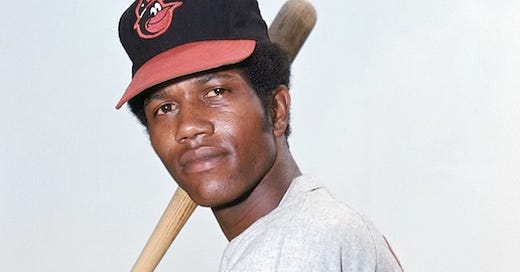The Bird Tapes Interview: Paul Blair
He won eight Gold Gloves, beginning a positional lineage that later included Adam Jones and Cedric Mullins. In 2000, he let his opinions fly in a memorable interview covering his entire career.
For my book about Orioles history, published a quarter-century ago, I journeyed all over the country, from Florida to Arizona, interviewing former players, managers and executives. But to sit down with Paul Blair, the Orioles’ signature centerfielder from their glory days in the 1960s and 1970s, all I had to do was take the North Avenue exit off the Jones Falls Expressway. Blair was Coppin State’s head baseball coach.
Fifty-five years old at the time, Blair was enjoying being a college coach even though his team had gone 1-44 in his first season. Talk about a rebuild.
Still, he made it clear he’d really wanted to become a pro coach, manager or scout in his post-playing years — and also made it clear why, in his opinion, that hadn’t happened.
“When you’re Black, you don’t have the same opportunities,” Blair said.
His pointed comment was typical of our long conversation in Coppin’s baseball office. In recounting the story of his life in baseball, which began when he signed with the New York Mets after his graduation from a California high school in 1961, Blair pulled no punches. He was honest and opinionated, as bold as he’d been as one of the finest-fielding outfielders of his, or any, era.
No one, not even Earl Weaver, dared tell him how to play his position.
Trading Frank Robinson after the 1971 season was a colossal blunder by the Orioles that resonated for years.
Reggie Jackson didn’t fit in during his one season with the team in 1976.
Those were just a few of the pearls Blair delivered in the interview, which is posted below in three segments as my latest Bird Tapes release.
I’ve been delighted by the response to the first three vintage interviews I’ve posted, with Weaver, Ernie Harwell and Brooks Robinson. But given the stature of each as a baseball immortal of sorts, that’s not surprising.
My interview with Blair, who died in 2013, presents a slight variation. It’s the first of many you’ll hear as a Bird Tapes subscriber in which the subject is indisputably famous and important in Oriole lore yet, perhaps, is a voice you haven’t heard quite as much, possessing a story you might not know quite as well.
Honestly, it’s what the Bird Tapes are all about — a dive into Orioles history that leaves out none of the big names but also goes “beyond the statues” and into the nooks and crannies of the franchise’s first five decades, illuminating what happened then and connecting it to what’s happening now.
Milt Pappas. Steve Barber. Harry Dalton. I could go on but, sorry, I’m going to limit the spoilers and build some suspense over the vintage interviews that lie ahead at the Bird Tapes. (Only paid subscribers have access to the interviews and full archive.)
Blair was 21 years old when he became the Orioles’ starting centerfielder in 1965. Jackie Brandt had held the job for six years and was a solid performer, a career .262 hitter who won a Gold Glove and made an All-Star Game appearance. But Blair represented a step up in terms of speed and potential.
Once he became the starter, he held the job for more than a decade, ultimately playing in 1,700 games as an Oriole. Not coincidentally, they made the playoffs in most of his seasons. Blair in center, Brooks Robinson at third base and Luis Aparicio followed by Mark Belanger at shortstop formed the backbone of a defense that played a central role in the Orioles’ dominance.
Keep reading with a 7-day free trial
Subscribe to The Bird Tapes to keep reading this post and get 7 days of free access to the full post archives.





